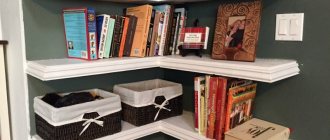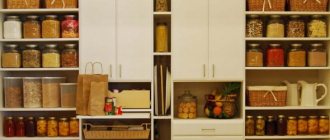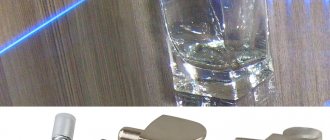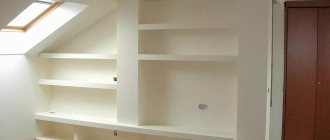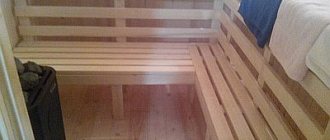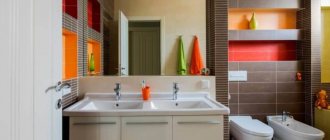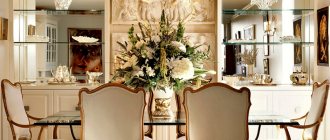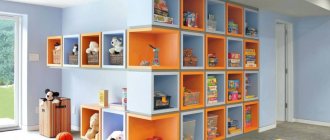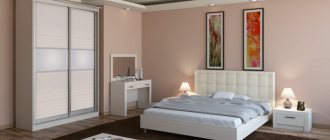It is absolutely impossible to imagine an apartment or a house, and even more so an office, without shelves. These are very multifunctional pieces of furniture that are used both for decorating space and arranging various souvenirs, and for convenient storage of various things. Often they fit so well into the interior that they are able to emphasize its style and individuality . But hanging shelves is sometimes not so easy. Often apartment owners want to secure them so that the fastenings are not visible. This is done in order to maintain the integrity of a particular style or for a number of other reasons. However, attaching shelves to the wall without visible fasteners is not such a difficult task as it seems at first glance.
Attaching shelves to the wall without visible fasteners
Shelves in a modern interior
In any house, if a person lives in it, there are always a lot of different jars, bottles, maybe books, souvenirs, photo frames and much more. And in order to keep order in the house, it is recommended to put each thing in its designated place. And often a wall shelf acts as such a place. It usually serves two functions - it is a convenient stand for something decorative or useful, and it can also be the highlight of a certain design.
Wall shelves in the interior
Depending on the room in which the shelf is installed, it can perform a very different role. So, in the kitchen there may be a set of spices on it or some elements of utensils. In the bathroom , a shelf is a must-have for arranging various bottles and bottles. A shelf is also needed in the bedroom , where you can place on it various things you need before going to bed. Of course, these interior elements are also in the living room - books, flowers, and souvenirs can be placed on them. Often they are able to significantly save space, as well as overcome clutter in the room, because from now on everything will be in its place. That is why this piece of furniture is absolutely irreplaceable, despite the fact that there may be many wardrobes or chests of drawers in the house.
Wall in the form of shelves
On a note! The shelf is appropriate and functional in absolutely any interior, regardless of its style. The main thing is to choose the right and suitable option and place it in a place where the shelf will look organic and as part of the interior.
Black and white shelf
Moreover, it is important to choose not only a shelf that suits the style, but also one that you will like and look aesthetically pleasing when hung. When creating certain styles, it is important that the fastenings on it are invisible. In general, there are several variations of fixing shelves on the wall.
Wood shelf
Prices for different types of shelves
Shelves
Making a shelf yourself: how to decide on the design and materials?
Any wall shelf can have a different shape and design. They can be complex (with additional elements) or simple. Simple shelves can be used in the kitchen.
They are used to store seasonings or kitchen utensils, so there is no point in coming up with a complex design.
It’s very easy to make semicircular shelves. This option is ideal if you don’t have the time or desire to do something more complicated. Also, simple shelves can be used in apartments and houses decorated in minimalist styles.
Such styles do not welcome complex shapes and intricate designs.
Shelves with additional elements can be used in living rooms. They can consist of several sections, or have an unusual shape, for example, in the form of the letter “L”.
Often such furniture occupies not only a corner, but also some part of the wall.
You can decorate such furniture using an original cutting method, if you have experience in this matter. The shelves placed in the corner also differ in the presence of a back wall. It may be present or replaced by a wall. If you want to preserve the decoration of the walls, then it is still better to build a furniture wall.
It doesn't require much effort.
In this article we will look at the process of constructing a classic-shaped corner shelf. This form is very simple and versatile. It won't even take two hours to make.
To get started, you need to decide not only on the shape of the product, but also on the material.
Let's look at the types of materials and their advantages.
To quickly decide on raw materials, be sure to consider the comparative characteristics presented in the table.
| Characteristics | Materials | |||
| Tree | Plastic | Glass | Metal | |
| Aesthetics | + | + | + | +/- |
| Durability | + | — | + | + |
| Ease of processing | + | + | — | — |
| Price | high | low | high | low |
| Moisture resistance | + | +/- | + | — |
| High temperature resistance | + | — | + | + |
| Strength | + | — | +/- | + |
Having analyzed all the characteristics, you can see that it is simpler and easier to create a corner shelf from wood.
In this article we will look at detailed instructions for making such furniture.
How can I mount a shelf on the wall?
To hang a shelf, you do not need to have great skills and abilities. Sometimes it is enough to have the shelf itself, a hammer drill and a building level on hand. Next, the work will go quickly and smoothly - hanging the shelf will take five minutes. However, these interior items can be fixed in different ways. This is often influenced by the type of shelf, the owner’s desire to use visible or invisible fasteners, and a number of other factors. Sometimes the type of fastener is important.
Table. Methods of fastening shelves.
| Mounting option | Short description |
| Bracket or holders | This option assumes the presence of visible fastenings for shelves. They can be seen, and they are fixed both below and above the shelf. The brackets can also be hidden. Visible brackets can be simple or decorative. They come in both plastic and metal, ornate and simple, etc. One side is attached to the wall, the other to the shelf itself. However, it is important to understand that this option is not suitable for every interior style. |
| Loops and corners | This is the choice of those who save on mounting costs, but want to install the shelf as quickly and easily as possible. It is suitable for almost every interior. Moreover, this is a fairly reliable fastener, and depending on its size, you can vary the load on the shelves. |
| Fastenings for glass options | These fasteners are used only for fixing shelves made of glass and characterized by their large mass and fragility. They are usually made of metal and have special gaskets that will allow you to securely fix the shelf itself to the wall, preventing it from falling. There are also suction cup fasteners for glass, but they are not very reliable. As a rule, the suction cup is fixed on the underside of the shelf. Typically, such fasteners are small in size. |
| Invisible | This option will allow you to install the shelf so that the fasteners themselves will not be visible from any side of the shelf. It will seem like it's just glued to the wall. |
Concealed shelf holder
Mounts without visible fasteners
Many people now choose fastenings without visible fasteners, since this option involves completely invisible fixing of the shelf on the wall , without unnecessary elements. It is the reluctance to see additional elements on the walls for one reason or another that drives the owners of shelves and apartments to choose this option.
Brackets for mounting shelves in the wall
There are three options to secure the shelf to the wall so that the fasteners are not visible.
- Using small hanging loops . In this case, the fixation is carried out using small loops that are attached to the back of the shelf and remain almost invisible. They are put on screws screwed into the wall in advance. In this case, it is important to apply the markings correctly and hang the shelf evenly. This fastener option is not suitable for products that do not have a frame as such, that is, shelves consisting of one board. Otherwise, the shelf will not hold up.
DIY zigzag shelf made of chipboard
Fastening with metal pins
The most reliable option for fixing the shelf is with metal pins, as this will provide the ability to seriously load the shelf. Moreover, this is the most inconspicuous option, even in comparison with other methods related to secret ones.
Prices for different types of bars
How to choose a fixation type?
This is not an easy task, since when choosing a method for attaching shelves, several factors must be taken into account. And they are the ones who will influence the final decision.
- The thickness of the wall itself on which the shelf is fixed. This is one of the main factors to consider when choosing a mounting option. The fact is that it is not always possible to use, for example, a hidden pin fastening. It is better to avoid it if the wall is made of soft materials such as plasterboard. The thickness of the partition should not be less than 10.5 cm if it is made of concrete, and less than 25 cm if it is made of brick. If the wall does not meet these parameters, then it is better to choose another fixation option. In relation to drywall, a shelf can be hung using a hidden fastener only if the wall thickness is at least 10 cm, and only light souvenirs and nothing heavy or giving a serious load will stand on the shelf.
Brackets for mounting shelves in the wall
- The thickness of the shelf itself and its weight also have a serious impact on the choice of fixation method. So, the shelf should not be too soft or damp. If you plan to place only light objects on it, then you can choose a shelf with a thickness of at least 3 cm, and if you plan to place heavy elements and possibly an increased load, then the shelf should have a thickness of at least 4.5 cm and no more than 6 cm.
Relationship between shelf depth and load on each mensolo holder
Important! You can choose the right mount only if you know the answers to the questions: “What will stand on the shelf?” and “Which wall will the product be fixed on?”, only then can you make the right choice.
It is also important to estimate the number of fasteners in advance. So, if the shelf is shorter than 1-1.5 m, then a couple of fasteners are enough. If the length is greater than the specified parameters, then it is better to increase the number of fasteners in order to evenly distribute the load on the product and the wall. Moreover, again, the number of fasteners can vary greatly depending on the thickness of the shelf itself and its quality.
The free space above the sofa is organically filled with shelves to match the walls
Types of fastenings
Hidden
The choice of hidden shelves is usually determined by the style of the room. Since this method is quite labor-intensive, preference is given only in cases of urgent need. This type of installation creates a feeling of lightness of the structure, expanding the space of the room. It is often used as an interior element in minimalist, ethnic Asian (Japanese, Chinese, Thai), modern, and high-tech styles.
Hidden hinges
They can be used for wooden shelves, laminated chipboard, plywood. The hinges are attached to the back of the shelf with self-tapping screws according to the markings. If this is a home-made product, then it is better to make indentations (cuts) in the places where the hinges are attached, according to the size and thickness of the fastening fittings, so that the hinges are flush with the edge of the product and tightly adjacent to the wall. Now you can hang it on the wall using screws screwed into it in advance.
Cantilever mount
In this section, we need to consider several types of mounting parts:
Metal rods
Now there is a large selection of console mounts on the market; ready-made shelves of various sizes can be selected with them. The design includes a hidden shelf holder for a wooden shelf and a bracket for attaching the shelf holder to the wall.
This method provides for the presence of holes in the shelf into which metal rods of furniture fittings will be inserted, and the rod should be 2-5 cm shorter than the product itself.
At home, you can construct such a cantilever mount yourself, using pieces of reinforcement and threaded rods complete with drive-in anchors as metal rods. And in the shelf itself, you need to drill holes in the size corresponding to the rods, observing the rule that they should be at least 2-5 cm shorter than the width of the product. In this case, the thickness of the rods ranges from 10 to 18 mm, depending on the weight of the future filling.
Wooden blocks
This method of fastening involves installing a frame made of wooden blocks, most often of square or rectangular cross-section, on the wall, and then stringing a shelf on them, which is a hollow structure (box). For reliability, the parts are secured with self-tapping screws; additional elements can be attached with glue.
Brackets, fasteners, corners
When choosing fastening with brackets, you must keep in mind that the fastening elements will always be visible. And this method may well become a decorative element in the interior.
After all, there is a wide variety of shapes, styles, and materials for making brackets. And therefore, shelves on brackets are used in interiors of classic, rustic, modern, modern, shabby chic, loft and other styles.
The choice in favor of such fasteners can be made not only because of their decorative appeal, they can provide reliability under significant loads - up to 30-50 kg.
Models and designs of brackets, materials for their manufacture and materials for shelves for which they can be used are quite diverse. Therefore, it will not be possible to give general recommendations on how to attach them.
But recommendations for installing shelves on brackets on the wall will be given below.
Fixing the shelf on the wall using hidden fasteners
Step 1. In order to fix a shelf on the wall using a hidden fastening option, you will need to prepare a hammer drill with a drill of a certain section, 2-3 special titanium pins, a building level, a square, a drill and a bit, the shelf itself, and a pencil for marking. The pin is a metal rod that is threaded on one side and smooth on the other. The threaded part will screw into the wall, and the smooth part will need to be fitted with a shelf. Typically the pin diameter is 10-12 mm. The drill is selected with the same diameter as the purchased titanium.
Special metal pin
Step 2. First of all, you need to apply markings to the shelf itself. By the way, you can make it yourself from any part of other furniture that has served its age, rather than buying new one. Using a ruler, you need to set aside the required distance from the end edge of the shelf. In this case, a distance of 12 cm was chosen.
Marking
Step 3. Having chosen the distance, you need, using a square and a pencil, to draw a line perpendicular to the plane of the shelf at the end where the hole for fastening will be drilled.
A perpendicular line is drawn at the end
Step 4. Next you need to find the middle of the end of the board and make a corresponding mark for the drill. It is important to understand that if the shelf consists of two sheets of chipboard glued together, then in this case it is better to drill a hole for fastening not in the middle, but with a slight offset towards one or another board (better - towards the bottom, it will be more reliable).
A mark is placed for the drill
Step 5. Similar markings must be applied on the opposite side of the shelf.
On the other side the same markings are applied
Step 6. Next, to the end of the shelf where the markings are applied, you need to attach a building level and directly on it make marks parallel to those previously applied to the board, as well as marking the edges of the shelf itself. The level cannot be moved while the marking is being transferred. Pencil marks can then be easily erased from the surface of the level, but this technique of transferring markings will make it easy to make markings for drilling holes in the wall.
The level cannot be moved while the marking is being transferred.
Marks are made at the level
Step 7. Then you need to select the approximate location of the shelf on the wall. Having applied it to the surface, you need to mark the boundaries of the product directly on the wallpaper with a pencil.
The shelf is attached to the wall
The boundaries of the shelf are marked
Step 8. Now you need to take a building level with markings and, attaching it to the wall in the selected and marked place, align and transfer the markings from the level to the wall, also using a pencil. In this way, you can easily and quickly make precise markings for the locations for drilling holes for the pins without unnecessary movements.
Transferring markings from level to wall
Step 9. Next, in the end part of the shelf, in the designated places, you need to drill holes for the pins. They should be the same depth as the length of the part of the pin on which the board will be placed.
A hole is drilled in the end
The depth of the hole should correspond to the part of the pin on which the shelf will be placed
Step 10. Now you need to take a hammer drill with a drill of the same diameter as the pin and make holes in the wall in accordance with the previously made marks. To prevent dust from concrete from falling onto the floor, it can be removed immediately using a switched on vacuum cleaner, the hose from which will be held by an assistant.
Holes are made in the wall
Step 11. Both titanium pins need to be installed in place, that is, inserted into the holes in the wall. If they are difficult to enter, you can carefully knock them out with a hammer or screw them into the wall using a key.
The pins are inserted into the holes
Step 12. All that remains is to put the shelf on the pins in the wall, aligning the holes with the metal fasteners. The shelf is installed. By the way, for better fixation, you can add a little glue to the holes of the shelf - then the connection will be even more reliable. This mounting option will allow you to achieve an effect where it seems as if the shelf is supported on the wall by itself.
The shelf fits onto the pins in the wall
Finished shelf without visible fasteners
Prices for popular hammer drill models
Hammers
Video - How to install a shelf with invisible fasteners
Features of fastening shelves depending on the type of wall
Concrete wall
The nuance of working in a room with concrete walls is the choice of drilling tool and drill bit. This should be a hammer drill and a special concrete drill made of hard alloys. The size of the drill, its diameter and length, is selected depending on the specific fastening hardware.
Plasterboard wall
If you plan to hang a shelf on a plasterboard wall that will serve a decorative role (for souvenirs, figurines or vases), then you can safely use a TNF/-W butterfly dowel to mount it.
To secure it in drywall, you need to drill a hole of the appropriate size and drive a dowel into it. When a self-tapping screw is screwed into such a dowel, it opens on its own, forming a reliable stop in the plasterboard sheet, and a special cuff on the dowel does not allow it to rotate. Fastening a light shelf made of glass, thin plywood or other lightweight material in this way will be quite reliable.
To install heavier shelves, more labor-intensive work will have to be done. At the stage of constructing plasterboard partitions, in the places where the shelves are planned to be attached, it is necessary to install additional transverse aluminum profiles or bars of the appropriate cross-section. It is in them that holes will be drilled through the drywall, dowels will be installed and brackets will be attached.
If such additional structures were not provided for at the stage of constructing plasterboard walls, then a solution can be found. Already on the outside of the plasterboard partition, you can attach a transverse bar to the vertical profiles located inside the plasterboard partition (in this case, their location must be known or determined, for example, by tapping or more technologically advanced methods). But in this case, the main task will be to make the bar invisible - for example, by hanging one long or several shelves in a row along the entire length of the bar. Or make it a decorative element.
Only part of the widespread methods and most common methods of attaching shelves in rooms has been described here. In addition to them, everyone’s imagination and experience can suggest other devices, designs and design solutions.
With all the variety of existing methods of interior design and modern design, it is almost impossible to imagine a modern room in which shelves would not be used.
Decorative and easy to store various small items, massive for books - shelves can not only be an additional useful surface, but they can also act as a decorative decoration for any room or office.
There are two main ways to attach shelves:
- traditional mounting of shelves to the wall
- invisible or hidden fastening of shelves to the wall
The traditional method of fastening using various types of brackets, metal or wooden racks is popular only when the fasteners, correctly selected in color, texture and material, also add their own “zest” to the artistic image of the room.
But often, the presence of additional decorative and technological elements is not always consistent with the overall design of the designer and the target orientation of the structures. In this case, it would be better to use the second fastening method.
The development of modern design craft and the construction industry makes it possible not only to quickly cope with the task of hanging shelves, but also to successfully use the fastening of shelves to the wall without visible fasteners, thereby creating the illusion of floating in space.
Invisible fastening of shelves to the wall
Let's consider the main stages of properly attaching a shelf to the wall, while hiding all fastening elements:
- First, you need to assess the strength of the wall or partition on which the shelf will be attached.
With a brick partition thickness of 250 mm or more, concrete partitions with a thickness of 100 mm or more can be safely used for hanging shelves without additional load-bearing structures.
Scheme of invisible shelf fastening.
1 – bracket for fastening the shelf; 2 – mounting holes; 3 – steel axle; 4 – suspension; 5 – shelf.
With thinner bricks, cinder block and plasterboard walls up to 100 mm, it is possible to use invisible fastening of shelves to the wall, but such shelves are suitable only for decorative purposes.
Since they simply will not withstand additional loads.
Then you need to determine the thickness of the shelf itself.
It can be determined by placing a load of expected weight on it. The absence of visual deflection and deflection to the touch indicates sufficient thickness of the board.
An exception may be cases when the choice of a thicker board is dictated by the general concept of the interior.
However, it is also necessary to take into account the fastening features, due to which the thickness of the board, as a rule, cannot be less than 30 mm. The thickness of the shelf must be selected depending on the load, for example, for books - boards with a thickness of 45 to 60 mm are suitable.
The board must be dry and processed in accordance with its purpose.
Types of fastening shelves to the wall
After this, the types of fastening the shelves to the wall are selected, depending on its purpose and the thickness of the board.
There are a huge number of fastening materials that can be expertly hidden from prying eyes; let’s look at some of them:
- The most popular at the moment is
the use of hidden hinges located on the back of the shelf.
Fastening technology using hinges:
For accurate hanging, you need to accurately measure the distance between the centers of the loops. This distance will determine the markings on the wall for the mounting holes. To ensure that the shelf hangs evenly and does not warp, it is better to use a building level, which will ensure an accurate horizontal line for the shelf. After the holes in the wall are drilled in accordance with the markings, they are filled with a plug into which screws are screwed. The screw should be screwed in deep enough, but the distance between its head and the wall should allow the shelf hinges to be put on.
The shelves come complete with special fasteners designed for invisible installation. A shelf installed in this way will be securely fastened. This will create a visual impression that it is literally hanging in the air.
Method of installing shelves using special furniture fittings
Let's look at the step-by-step implementation of this installation.
It starts with purchasing a modern shelf in a furniture supermarket or online store.
Step 1. Measure the distance between the centers of the mounting holes directly on the product.
Step 2. After this, mark the location of the shelf on the wall. Using a building level, we draw a horizontal axis on which we mark the position of the mounting holes, taking into account the center-to-center distance between them.
Step 3. Next, we attach the bracket to the resulting axis in the center of the shelf holes and mark the places for its future attachment to the wall. They must be located strictly along the horizontal axis.
Step 4. The next step is to drill a hole for attaching the brackets. They must be made strictly perpendicular to the wall, this will ensure that the shelf angle is 90 degrees relative to the wall. To simplify drilling, it is advisable to use a square.
Step 5. Next, remove the remaining drilling products from the holes and hammer in wood plugs or plastic dowels.
Step 7. Now we carry out the direct installation of the shelf. To do this, we put it on the steel axles of the brackets, alternately tapping it with a rubber hammer on the left and right sides in the front part. The shelf will be evenly installed on the fastening elements, eliminating distortions.
Step 8. The final stage will be to check the play and reliability of the fastening. After this, we remove the remaining debris and install a flowerpot with an orchid. The installation process is complete.
